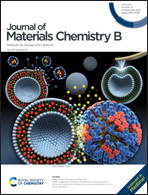Highly resilient, biocompatible, and antibacterial carbon nanotube/hydroxybutyl chitosan sponge dressing for rapid and effective hemostasis†
Abstract
Uncontrolled hemorrhage is the leading cause of trauma death. The development of safe and efficient hemostatic agents that can rapidly and effectively control bleeding is of great significance to rescue the injured. However, the mechanical, absorptive, and antibacterial properties of conventional two-dimensional hemostatic agents are not satisfactory. Herein, a series of effective three-dimensional hemostatic dressings (JWCNT/HBC sponges) are developed by chemical modification of joint-welded carbon nanotube (JWCNT) sponges with hydroxybutyl chitosan (HBC) for hemorrhage hemostasis. The JWCNT/HBC sponges exhibit high elasticity, porous structure, and suitable blood-absorption and blood-maintaining performance. Moreover, the introduction of HBC endows the JWCNT/HBC sponges with favorable blood compatibility and good antibacterial activity. The sponge treated with 0.5% HBC (JWCNT/0.5%HBC sponge) displays better antiseptic capability, faster blood clotting ability in vitro and shorter hemostasis time in vivo than the commercial gelatin sponge. The JWCNT/HBC sponges combine the advantages of JWCNT sponges and HBC in the adhesion and activation of platelets and red blood cells, thus becoming a good medical material for trauma hemostasis.



 Please wait while we load your content...
Please wait while we load your content...